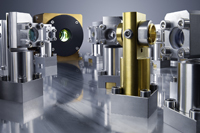11 May 2015
Everything from a single source
 Laser specialist TRUMPF is making preparations for an appearance at Laer2015 in Munich. As the industry leader both in the global market and in terms of technology, TRUMPF will be showing its broad portfolio of products and technologies and, at the same time, is reinforcing its claim as a guarantor of innovations in the world of lasers. No matter whether it is a question of welding, cutting, marking or other laser-based processes – TRUMPF will be showing new and improved concepts for a lot of application sectors, both industrial and scientific.
Laser specialist TRUMPF is making preparations for an appearance at Laer2015 in Munich. As the industry leader both in the global market and in terms of technology, TRUMPF will be showing its broad portfolio of products and technologies and, at the same time, is reinforcing its claim as a guarantor of innovations in the world of lasers. No matter whether it is a question of welding, cutting, marking or other laser-based processes – TRUMPF will be showing new and improved concepts for a lot of application sectors, both industrial and scientific.
Wide range of applications in microprocessing
In the limelight here will be microprocessing using picosecond and femtosecond lasers. TRUMPF is expanding the product line in its TruMicro series to include additional beam sources. It will also be equipping these laser systems with new optical systems. Hard and brittle materials such as glass, ceramic and sapphire can be worked with TRUMPF’s new picosecond lasers both flexibly and without additional chemicals. The benefit: Retouching work for the product is completely eliminated here. Current applications in the consumer goods industry – such as cutting touchscreen films or flexible displays, and welding batteries or metal cases – can be done both effectively and, above all, profitably with the new TruMicro lasers. At the show in Munich, TRUMPF will be presenting not only its lasers, but specific sample parts and examples of applications, as well.
Another highlight will be the TruDisk lasers. They produce up to six kilowatts of laser power from just a single disk, boast more than 30 percent efficiency, and can process even highly reflective materials without limitation. Thanks to its unique resonator design, the TruDisk laser by TRUMPF is absolutely insensitive to back-reflections. This makes it stable and reliable in the production process.
The laser diode is the key
Energy efficiency and “green production” are catchwords that have high standing at TRUMPF. At the fair in Munich the company will be exhibiting the most recent generation of its TruDiode lasers. “Further development in the diode-pumped, solid-state laser and the direct diode laser is enormously important for us, explains Dr.-Ing. E.h. Peter Leibinger, head of the Laser Technology and Electronics division. He continues: “With their efficiency of up to 40 percent, they are extremely energy efficient and in this way offer decisive advantages.” In direct diode lasers the laser radiation produced by the diodes is bundled into a beam. This makes the beam source very compact. During welding, soldering and surface applications of up to six kilowatts, TRUMPF achieves superior results with its TruDiode lasers.
Intelligent sensors make for efficiency when welding fillet welds
TRUMPF is devoting special attention at this year’s Laser trade show to its own process sensors. To achieve a stable, rugged and reproducible process during laser welding, reliable sensor systems are a decisive factor. That is why TRUMPF has developed a variety of sensors and offers solutions for a wide variety of demands. By using appropriate sensor systems the tool, the workpiece position, and the process itself can be monitored and controlled precisely, right at the workpiece. These sensors, for example, lend stability to critical process parameters such as laser output and beam position and make corrections as needed. In addition, processing sensors can spot deviations from dimensional and position specifications and compensate for these. At the same time they can make projections on the quality of the welding seams. SeamLine Pro, a familiar and time-tested sensor system, helps the welding beam to meet the seam gap exactly. In the case of remote applications using a scanner, this task is assumed by a sensor system newly developed by TRUMPF. Here a high-speed camera, located almost coaxial to the laser beam, senses the seam and the position of the laser focus point simultaneously and adjusts the focusing optics so that the laser beam actually hits the seam. This new system is interesting especially for the automotive industry, because increasing numbers of robots and programmable focusing optics are being used for fillet welds. The advantage of fillet welds is that they enable small flanges. This saves weight and material, increases energy efficiency, and reduces costs. To weld a fillet cleanly, the laser beam has to strike the seam very exactly, and this is exactly what the new sensors guarantee.
Image: Optical configuration from a TruMicro microprocessing laser
- Contact Information
- Name: Gerry Jones
- Email: g.jones@uk.trumpf.com
- Website: www.trumpf.com

